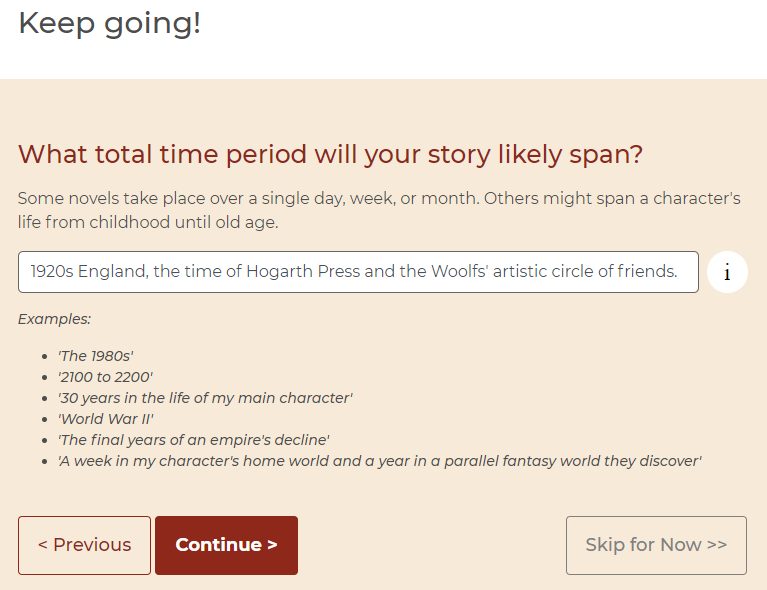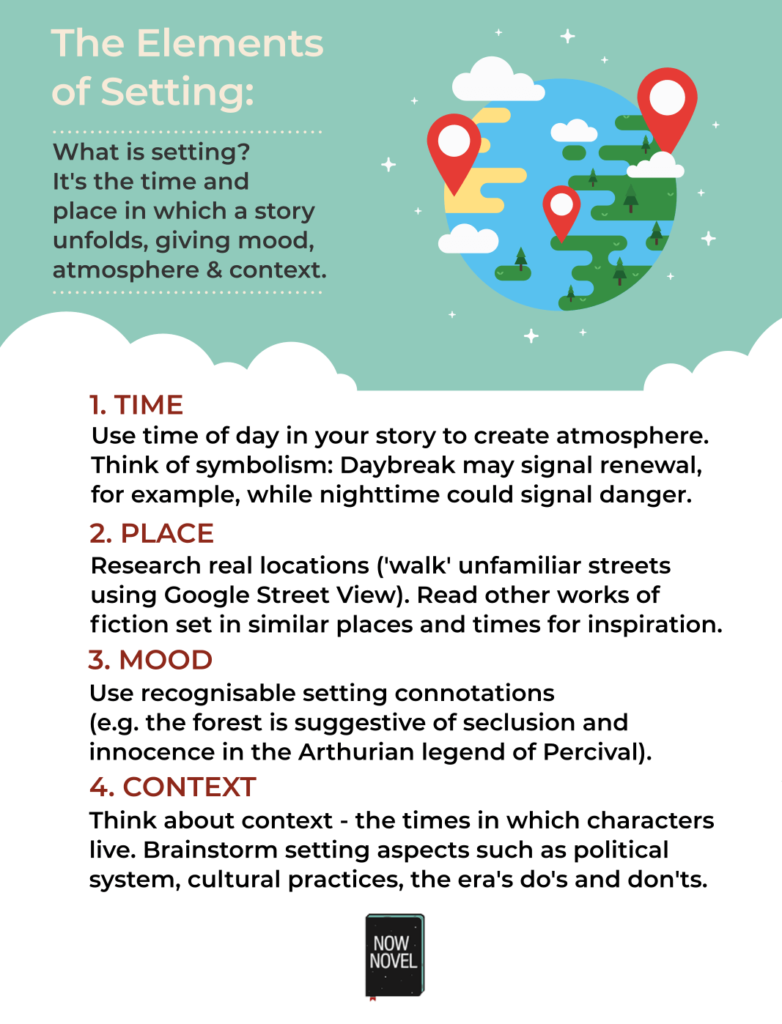The elements of setting - time, place, mood, social and cultural context - help to make a novel feel real and alive. This is an essential element of writing that helps anchor your writing within a specific place. Read more about using the ingredients of setting to make your story more vivid:
Defining setting
Let's first define setting. This can be the time frame or/and the location, and environment in which your story takes place. Setting is as vital a part of your story as characterisation or plot. Some novels are rooted in setting, such as many mystery novels where the setting becomes vital to the action. But many stories rely on setting, so it's worth getting this right and creating your fictional world in detail.
What are the 4 key elements of setting?
The core elements of setting are:
- Time
- Place
- Mood
- Context
Time in setting can refer to the length of time in which the story unfolds (as short as a day or as long as 1,000 years or more).
Time can also refer to time period, the historical epoch (for example the Middle Ages) in which your novel is set. [When you brainstorm your core setting in the Now Novel dashboard, answer prompts about both to add time details to your story's outline.]

‘Place' is the ‘where' of story setting. Place in your novel is the geographical location or or physical location of the story's events, fictional settings that take place on a specific planet (or in space), in a specific country, county, city or neighbourhood (or span several).
The 'mood' of a story's setting refers to the tone you create by providing details of time and place. The mood of a dank and rustling wood is very different to that of a bustling, bright metropolis.
Lastly, 'context' in setting refers to the way time and place come together to show how elements of setting (such as politics, culture, society) shape (or limit) people's choices and actions.
Read the following tips on using each of these 4 elements of setting well:
1. How to create a sense of time in a novel
A. Use time of day to dramatic effect
Details such as the time of day add colour and variety to your novel's mood. Characters leaving on a mission in the dead of night instead of the daytime may create a much greater sense of urgency, threat or secrecy, for example.
Think also of the symbolic meanings people attach to time in stories. Daybreak can symbolize rebirth, renewal or the return of safety. Nighttime could symbolize danger, mystery or death. Or peace, tranquility, solitude.
Even if you don't explicitly reference the time of day or year in a scene, it can help to add one to your outline so that you have other details in mind as you draft and describe your scene.
B. Show time passing to create urgency or anticipation
Show time passing in your story setting to help the reader see that the action of your story unfolds within a shifting, changing world.
A classic example of this we return to often is the ending of Evelyn Waugh's Brideshead Revisited. The protagonist returns to a grand manor he once knew to find it damaged considerably in the war. This passage of time creates a nostalgic, 'you can't go home again' effect.
A sense of time passing is especially important where there is urgency. In a murder mystery, for example, each passing sunrise and sunset without a new lead is another opportunity for the 'baddie' to strike.
Showing how time's passage changes your setting is a great way to add development to your story's backdrop.
C. Make your time period realistic
It takes readers out of your story when you have a medieval knight saying 'that's sick' or 'cool'.
Unless your characters are supposed to time-travel, make sure your time setting is realistic and consistent.
Also ensure that you have a handle on the social environment (or cultural environment) of the setting of your story. What world or political events take place in an historic setting, and how might this contribute to the plot, for example? What is the etiquette like: are women allowed to walk the streets alone?
If you're writing historical fiction in particular, keep a cheat file of every detail about your setting. Research what people ate, wore and believed and how they spoke. You don't have to include every detail in your draft (indeed, a good editor will cut redundant or excessive details about setting). Some information is just for you to know, so you can keep details believable.

2. How to write place in a book
The second key element of setting, place, is equally as important as time. If your characters' actions are anchored in a vivid location, they will seem much more real. To make your story locations vivid:
A. Research real locations thoroughly
Setting your book in a real place means that you need to understand it: Not only its geography but also what kind of life a traveler would find there.
To research a real contemporary location:
- See if it's available to explore using Google Street View - your own virtual guided tour will make it much easier to describe
- Read through information about your chosen real-world setting on regional government websites.
- Read other works of fiction set in the same place and time. Many fiction writers take liberties with describing real places. But creative accounts can develop your own imaginative grasp of a place
Even if your fictional world is entirely made up - a distant planet in the solar system that has been colonized in the year 5000, for example - you can base it on a real world location for inspiration.

B. Show place with description
'Show don't tell' is repeated so often that you're probably tired of hearing it. But this is especially true for place description in setting.
Instead of just telling the reader that the train rolled into the big city, show the big city. Describe some of its buildings, or its landmarks, or the faces on the station platform [Brainstorm individual locations such as landmarks or a station by creating a 'small-scale setting' in the World Builder on Now Novel].
Describe the features that would strike a newcomer most. The better you observe and show place in your novel, the easier it is for readers to enjoy your fictional world.
C. Go there if possible
If you're writing about a real place and you've never been there in person, go if it's at all possible. As writer Suzannah Windsor Freeman says, when creating a story setting sometimes 'research doesn't cut it'.
Research and looking at photos of the destination combined can give you enough material to create a keen sense of place, but actually walking the streets where your novel is set will help to inspire your storytelling and enrich it with plenty of detail.
3. How to create mood in your story's setting
Creating a precise mood with your setting is important because:
- It signals to the reader how they should read the unfolding action: Is there a sense of danger or adventure? Is the story reaching a point of higher stakes or is the action winding down?
- It creates contrast - the light and shade - that keeps a story's environments interesting and believable
Setting can also be used to contribute to the plot and perhaps show the character development of your cast. For example you can show that a character has grown up and become more responsible because their house has been freshly painted, and looks neat now.
Some tips for using the elements of setting to establish a clear mood:
A. Use common connotations of places and times
Different places are associated with different things: A mountain pass might be associated with travel and adventure while the seaside might be associated with relaxation and introspection.
Similarly, winter might be associated with introspection or depression while summer is associated with extroversion and a jubilant mood.
If you want to emphasize that a negative situation is turning around for your character, you might show the transition to a new life alongside a change in the seasons.
Underscoring the action of your novel with mood this way heightens its sense of drama and change.
B. Show how time and place affect characters' moods
You could use the mood of your setting to also reveal aspects of your characters' personalities and desires.
For example, if your character loves to spend time in a library, this may show that they are an intellectual person (or simply a person who loves books or quiet).
Think about the relation between place and time and how your character might change depending on their surrounds.
4. How to write context for your story's setting
Context is one of the most important elements of setting for plot. The social, cultural, historical, political and environmental details tied to time and place shape people's lives in many ways. Creating this context for story settings is important because:
- It shows what possibilities and limitations are placed on your characters by their place and time
- Context gives readers a more detailed sense of your fictional world (readers know how power is divided, how people celebrate, and other cultural details).
To make the context element of your setting more real:
A. Think about how society is organised in your setting
Let's consider the environmental setting of your world, not just the scenery, but what is happening socially and politically. Think about the kind of your society your characters live in. From country to country, different cultural practices are the norm. Think about what the practices will be in your novel's own place and time. Will your main character uphold these traditions or challenge and rebel against them?
B. Make notes on every aspect of a real-world context
If your novel is set in a real-world time period and location, make notes on all the context-related elements of setting. Do light research and summarize information about:
- Demographics (what is the social makeup of your setting: What different groups and belief systems occupy the land?)
- Political system
- Social views (are most people leftist, centrist or on the right of the spectrum?)
- Cultural practices (For example, what is the standard greeting? What words or gestures are considered offensive?)
Your novel doesn't need to reference each of these elements explicitly (a romance novel most likely won't explore politics). Yet having an idea of the most dominant viewpoints and ways of life of a place and time will help you to create characters and dialogue that feel right for the setting.










This is the factor that will bring the world that you created to your readers, connecting them to it. That is why you need to put more effort into making your setting come alive. If you don’t mind, I want to know your thoughts about this blog: https://gregvanarsdale.com/guide-to-creating-vivid-setting-for-your-fiction/ I will surely appreciate your opinions.
Lydia Dean - Almost 4 years ago
Hi Lydia, thank you for sharing that. I would say it could use a little further editing for paragraph structure and length, as well as more headings. Clarity and argument could be tweaked a little too, but it's on its way.
Jordan - Almost 4 years ago